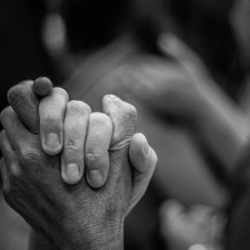Welcome readers! Please subscribe through the buttons at the right if you enjoy this post.

I want to begin with another common objection to interpreting Jesus as teaching nonviolence. If Jesus taught nonviolence, why does the rest of the Bible seem to endorse or even command violence?
I agree with Philip Jenkins, author of Laying Down the Sword, that we must not “ignore the Bible’s violent verses.” Christians have repeatedly used the violent passage and commands of the Bible as a basis for their actions during the last two millennia, making Christianity the most violent world religion to date. Yet before the Roman empire embraced the Christian religion, Christianity was a religion of pacifists who believed Jesus taught his followers to practice some form of nonviolence. (See Part 1 and Part 2).
So what do we do with the violence of the Bible? First, we need to be honest about it. The Bible, to which the Jesus story belongs, is a very violent book overall. From Genesis to Revelation we are accosted with violence, both human and Divine.
Second, we need to understand the social-political context of Jesus’ nonviolence was Jewish society under a very heavy-handed Roman control.
Jesus had options for what form his resistance to injustice would take. He chose nonviolent, self-affirming resistance as his means of change. Jesus chose to embrace and teach his followers nonviolent forms of resistance that some first-century Jewish resistance efforts were already using.
In his volume The Greatest Prayer: Rediscovering the Revolutionary Message of the Lord’s Prayer, John Dominic Crossan shares a brief history of violent and nonviolent Jewish resistance movements within the culture of the gospel stories. Three significant Jewish rebellions stand out in that context:
The first was the Judas Rebellion under the reign of the Roman Emperor Augustus. It took place in Sepphoris in 4 BCE. Josephus tells us how Rome responded to this rebellion. The Roman Governor in Syria, Varus, had first “committed part of [the soldiers] to his son, and to a friend of his; and sent them upon an expedition into Galilee: which lies in the neighbourhood of Ptolemais. Who made an attack upon the enemy, and put them to flight, and took Sepphoris, and made its inhabitants slaves, and burnt the city.” (Antiquities of the Jews, 17.288–89). Varus then marched on to Jerusalem. He “sent a part of his army into the country, to seek out those that had been the authors of the revolt: and when they were discovered, he punished some of them that were most guilty; and some he dismissed. Now the number of those that were crucified on this account were two thousand.” (Antiquities of the Jews, 17.295)
Think of the psychological damage to the rest of the population of seeing 2,000 crosses with rebels crucified on them along the Jewish countryside. What message would this have sent? Rev. Dr. Kelly Brown Douglas reminds us that “Crucifixion was a stand-your-ground type of punishment for the treasonous offense of violating the rule of Roman ‘law and order’” (in Stand Your Ground: Black Bodies and the Justice of God, p. 171).
The second major Jewish rebellion during the time the gospels were written was the Roman Jewish War of 66-69 CE under the Roman emperor Nero. This ended in the destruction of the Jewish Temple and in Jerusalem being burned to the ground.
The third rebellion was the BarKokba Revolt from 132-136 CE. Rome killed more than half a million Jews in this war, and more died from starvation and disease. Rome also sold Jewish war captives into slavery. (Menaḥem Mor, The Second Jewish Revolt the Bar Kokhba War, Page 471) So great was the devastation from Rome’s backlash after this third rebellion that Joan Taylor states “the crucial date for what can only be described as genocide, and the devastation of Jews and Judaism within central Judea, was 135 CE and not, as usually assumed, 70 CE, despite the siege of Jerusalem and the Temple’s destruction” (in The Essenes, the Scrolls, and the Dead Sea. Oxford University Press, 2014. Page 243)
We must understand Jesus’ teachings on nonviolence in terms of the historical reality that the Jewish people picking up the sword against Rome would not have been an act of liberation but an act of suicide. Jesus would have grown up in the wake of the destruction of the first Jewish rebellion we discussed above, and his nonviolence held thriving, surviving, and liberation in tension.
But what about those 1st Century nonviolent resistance movements we spoke about earlier? Nonviolent resistance movements, though less popular, were also used by the Jewish people during this time. We’ll consider two that we have a record of.
The first is the Ensigns Incident in 26 CE. If Jesus had been on the fence before emerging in Galilee as a teacher of nonviolence, the incident would have taken place just before his ministry began and could have influenced his thinking on the potential success of nonviolent resistance.
Josephus tells us:
“As procurator [Greek: “hegemon”] of Judaea Tiberius sent Pilate, who during the night, secretly and under cover, conveyed to Jerusalem the images of Caesar known as standards. When day dawned this caused great excitement among the Jews; for those who were near were amazed at the sight, which meant that their laws had been trampled on — they do not permit any graven image to be set up in the City — and the angry City mob was joined by a huge influx of people from the country. They rushed off to Pilate in Caesarea, and begged him to remove the standards from Jerusalem and to respect their ancient customs. When Pilate refused, they fell prone all round his house and remained motionless for five days and nights.
The next day Pilate took his seat on the tribunal in the great stadium and summoned the mob on the pretext that he was ready to give them an answer. Instead he gave a pre-arranged signal to the soldiers to surround the Jews in full armour, and the troops formed a ring three deep. The Jews were dumbfounded at the unexpected sight, but Pilate, declaring that he would cut them to pieces unless they accepted the images of Caesar, nodded to the soldiers to bare their swords. At this the Jews as though by agreement fell to the ground in a body and bent their necks, shouting that they were ready to be killed rather than transgress the Law. Amazed at the intensity of their religious fervour, Pilate ordered the standards to be removed from Jerusalem forthwith.” War 2:175-203
The second example of Jewish nonviolent resistance is the incident over the statue of Gaius Caligula that Caligula attempted to erect in the Temple in 40 CE.
The following is Josephus’ account of the mass demonstration in response:
“Meanwhile, tens of thousands of Jews came to Petronius at Ptolemais with petitions not to use force to make them transgress and violate their ancestral code. They said, ‘If you propose at all costs to set up the image, slay us first before you carry out these resolutions. For it is not possible for us to survive and to behold actions that are forbidden us by the decision both of our lawgiver and of our ancestors. … In order to preserve our ancestral code, we shall patiently endure what may be in store for us… for God will stand by us; Fortune, moreover, is wont to veer now toward one side, now toward the other in human affairs.’ Petronius saw that they were determined and that it would be impossible to carry out Gaius’ order without great conflict and slaughter. He went to Tiberias to determine the situation of the Jews there. Again, many tens of thousands faced Petronius on his arrival. They besought him to not put up the statue. ‘Will you then go to war with Caesar, regardless of his resources and of your own weakness?’ he asked. ‘On no account would we fight,’ they said, ‘but we will die sooner than violate our laws.’ And falling on their faces and baring their throats, they declared that they were ready to be slain. They continued to make these supplications for forty days. Furthermore, they neglected their fields even though this was the time to sow the seed. For they showed a stubborn determination and readiness to die rather than to see the image erected.
“Then members of the royal family and civic leaders appealed to Petronius to refrain from the plan and instead to write to Gaius telling how incurable was their opposition to receiving the statue and how they had left their fields to sit as a protest, and that they did not choose war, since they could not fight a war, but would be glad to die sooner than transgress their customs, and that since the land was unsown there would be no harvest and no tribute. They brought pressure to bear upon him in every way and employed every device to make their plea effective. Petronius was influenced by their plea, and saw the stubborn determination of the Jews, and thought it would be terrible to bring death on so many tens of thousands of people. He thought it best to risk sending a letter to Gaius. Perhaps he might even convince him to cancel the order. If not, he would undertake war against the Jews. And thus Petronius decided to recognize the cogency of the plea of the petitioners.” Antiquities 18:261-309
Again, this is the landscape upon which the gospels were written. The early Jesus community, which wrote the gospels, chose the path of nonviolence.
How did early Christianity reconcile this ethic of nonviolence with the rest of their sacred text? Let’s stop for a moment and first ask that question of ourselves.
Have you ever felt that in order to do what was right and ethical you had to go against your understanding of what you believed your sacred text taught? Remember, our sacred texts can be eternal while our interpretations are temporary. We must learn to distinguish between our sacred texts and our interpretations of them. We can choose to allow older destructive interpretations that do harm to marginalized communities to give way to new life-giving interpretations for everyone, the marginalized especially.
This is the story of early Christianity. To do what they believed was right, early Christians had to go against their understanding of what they believed their sacred text had previously taught. They created or discovered new ways of interpreting their sacred text, informed by the teachings of Jesus.
We see another illustration of this in the first verses of the New Testament book of Hebrews:
“Long ago, God spoke to our ancestors in many and various forms by the prophets, but in these last days, he has spoken to us by a son [who is the] radiance of God’s glory and the exact representation of his being.” (Hebrews 1:1-3)
New ways of interpreting their sacred texts emerged to replace the old. I’m sure this was just as unsettling for those back then who did not like change as it is for certain Christians today.
I have to confess, too, that I deeply wrestle with the violence I see in our sacred text, the Bible. A lot of Christian authors try and justify the violence in the Bible, conflating it with punitive or preventive justice. Their goal is to make that violence look fair or the lesser of two evils. While I admire their efforts to make these passages look less ugly, they really don’t solve my problem with Biblical violence. There is a world of difference between reconciling the violence of the Bible with justice and reconciling the violence of the Bible with Jesus and his teachings on nonviolence. One may be able to justify an example of violence in our sacred text, but the Jesus of the gospels didn’t teach justified violence or what is today called just war theory. The Jesus of the gospels taught resistance that was self-affirming and nonviolent.
The moral standard for a follower of Jesus is not the Bible. It’s not the ten commandments. It’s not even our interpretations of the Gospels. The Jesus we claim to follow taught that “a tree is known by its fruit” (Matthew 12:33 cf. Luke 6:44). This means that we can know whether we are interpreting our sacred texts in harmful or life-giving ways by the fruit that interpretation produces. Is our understanding certain stories and passages producing life, especially for the “least of these,” or is it harming others? The moral standard for a Jesus follower, according to Jesus, is to do no harm and to treat others the way you yourself would like to be treated.
This series is a call to all of those who claim to follow the Jesus of the gospels to return to what he taught about our relation to violence. When we bump into what we could interpret as a Biblical endorsement of violence or as Biblically mandated violence, we must hold those passages as secondary to Jesus and his rejection of violence in the gospels.
Last week, as the U.S. remembered the events of 9/11, a friend of mine who is a pastor, Daniel Wysong, posted this relevant reminder on Facebook:
“My hope in remembering 9/11 is that we would learn the lesson that killing people is horrible. The 2996 people who died on 9/11/2001 shouldn’t have. Nor should the 7000 US service members that died in the wars in Iraq and Afghanistan. Nor should the ~100,000 police and guard members. Nor should the ~300,000 Iraqi and Afghani civilians. Every single one of those lives lost is a tragedy of equal proportion.
If we wish to honor the memory of those who have been killed, it can only be by remembering that violence is horrible. And remembering that violence begets violence. And intentionally moving towards a world with less killing.
We honor their lives by learning and remembering that we will never create the world we all want to live in by killing enough people.” (https://www.facebook.com/danwysong7/posts/10219666062303603)
May followers of Jesus come to be known in our society as those who reject violence, once again.













